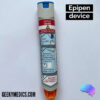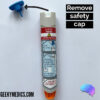- 📖 Geeky Medics OSCE Book
- ⚡ Geeky Medics Bundles
- ✨ 1300+ OSCE Stations
- ✅ OSCE Checklist PDF Booklet
- 🧠 UKMLA AKT Question Bank
- 💊 PSA Question Bank
- 💉 Clinical Skills App
- 🗂️ Flashcard Collections | OSCE, Medicine, Surgery, Anatomy
- 💬 SCA Cases for MRCGP
To be the first to know about our latest videos subscribe to our YouTube channel 🙌
Explaining the use of an adrenaline auto-injector is a common potential OSCE scenario. You will need to explain why the patient has been prescribed an adrenaline auto-injector, when they should use it and how to use it. This step-by-step guide describes how to explain the use of an adrenaline auto-injector in an OSCE setting.
For the purposes of this guide, the EpiPen® brand of autoinjector will be used.
Opening the consultation
Wash your hands and don PPE if appropriate.
Introduce yourself to the patient including your name and role.
Confirm the patient’s name and date of birth.
Check the patient’s current understanding of using an adrenaline auto-injector, allowing you to better tailor your explanation.
Position the patient so that they are sitting comfortably.
Explanation
Overview
Provide a general overview of the patient’s adrenaline auto-injector:
- “You have been prescribed an EpiPen for your allergies as you recently had a severe allergic reaction.”
- “It is used to give yourself adrenaline for the emergency treatment of severe allergic reactions (anaphylaxis)”
- “This is what the injector looks like”
Brands of auto-injector
There are a variety of auto-injector brands available including:
- Epipen®
- Jext®
- Emerade®
They all look slightly different and have differing instructions for use, so if the brand is changed the patient will need re-training. But the situations in which they should be used, and the general process, are the same.
Features of the EpiPen
The EpiPen has several features that the patient needs to be aware of:
- “Each pen should have a blue safety cap on the top, this will stop it from being activated by accident.”
- “There is a viewing window in the EpiPen, you should check this regularly to make sure the solution inside is clear and colourless. If the solution has changed colour, then you will need to replace your EpiPen.”
- “You will also need to check the expiry date and replace your EpiPen when the date has passed, there are automatic alert services you can sign up to online to help with remembering this.”
- “The orange piece of plastic at the bottom is the needle cover, and makes sure the needle inside stays covered before and after use.”
When to use an EpiPen
EpiPens should be used to treat severe allergic reactions, known as anaphylaxis. You will need to explain the symptoms of this and when the patient needs to use their EpiPen:
- “EpiPens are used to treat severe allergic reactions, known as anaphylaxis.”
- “Symptoms can vary from person to person, but they will generally develop suddenly and get worse quickly after exposure to an allergen.”
- “Symptoms of anaphylaxis include feeling lightheaded or faint, breathing difficulties, wheezing, a fast heartbeat, clammy skin, confusion and anxiety, collapsing or losing consciousness. If you begin to experience these symptoms, then you should be prepared to use your EpiPen.”
- “Anaphylaxis is a medical emergency and is potentially life-threatening, so it is important to treat early.”
Check the patient’s understanding
Ask the patient to summarise the key points back to you to check their understanding:
- “To make sure you’ve understood everything so far could you tell me about the EpiPen you have been prescribed, how to check it is safe to use and when to use it. Don’t worry if you can’t remember everything as we can go back over the important information.”
Demonstrating the use of an EpiPen
This guide focuses on the procedure for an EpiPen brand auto-injector.
Ensure you clearly explain and demonstrate the following steps to the patient using a training pen (dummy injector).
Explain that the dummy injector is safe to use on a person and does not contain a needle. They will be given a dummy injector that they can use to train other people. They should never use their actual EpiPen for training purposes due to the risk of accidental injection of adrenaline.
Before using an EpiPen
Before using an EpiPen you should advise the patient to check the following:
1. Check the viewing window to make sure the solution is clear and colourless
2. Check the EpiPen is within its expiry date
Procedure
Preparation
1. Remove the EpiPen from the carry case
2. Pull off the blue safety cap
Administration
3. Hold the EpiPen in your dominant hand with the orange needle cover at the bottom: “Blue to the sky, orange to the thigh”
4. In a swinging motion, jab the EpiPen firmly into the outer thigh at a right angle: “You can use it over clothes, but not over zips, buckles or seams of clothes”
5. Hold it in place firmly for 3 seconds: “Try saying 1 elephant, 2 elephants, 3 elephants to count, as people tend to count faster when they are anxious or scared”
6. Remove the EpiPen and keep it with you to take to the hospital
After using an EpiPen
7. Dial 999, ask for an ambulance and say anaphylaxis and provide your location if able to
8. Lie down with your legs slightly raised while waiting for the ambulance
9. If you have a second EpiPen you should use this after 5-10 minutes if the ambulance has not arrived yet
10. Take your used EpiPens with you to the hospital
Assess the patient’s technique
Ask the patient to use the dummy injector as demonstrated and observe them.
Provide feedback based on what you observe to allow the patient to refine their technique.
Point out the positives…“You are doing X&Y very well”… then introduce room for improvement …“but doing A&B may help ensure you are using the EpiPen correctly.”
Continue to repeat the cycle of observation and feedback until the patient is able to use their EpiPen effectively.
General EpiPen information
Patients should be given general information about the storage, care and use of EpiPens:
- “Keep the EpiPen in the outer casing to protect it from light”
- “You should have access to 2 EpiPens and you will need to carry them with you at all times”
- “You should inform your workplace about your allergies and where to find your EpiPens if you suffer an allergic reaction at work”
- “You should also teach family and friends how to use your EpiPens using the dummy injector”
- “If you have to use your EpiPens for an allergic reaction, make sure you do not leave the hospital without a replacement”
Closing the consultation
Check if the patient has any questions regarding their EpiPen and when to use it.
Advise them that they may wish to purchase a medic alert bracelet or similar in case they are unable to communicate their allergy.
Provide an information leaflet for the EpiPen and ensure they have a dummy injector they can use to train others.
Ensure they know to take any EpiPens that are expired or have discoloured solution to a pharmacy so they can be replaced.
Thank the patient for their time.
Dispose of PPE appropriately and wash your hands.
Editor
Dr Chris Jefferies
References
- EpiPen. How to use your EpiPen. Available from [LINK].
- Anaphylaxis campaign. Signs and symptoms of anaphylaxis. Available from [LINK].
- Patient info. Adrenaline for anaphylaxis. Available from [LINK].








